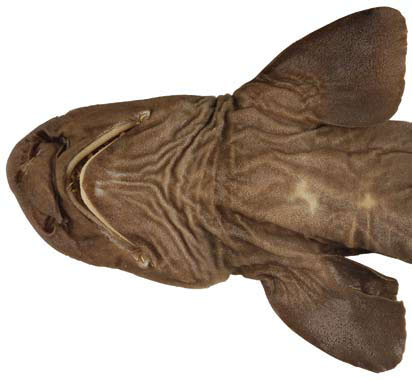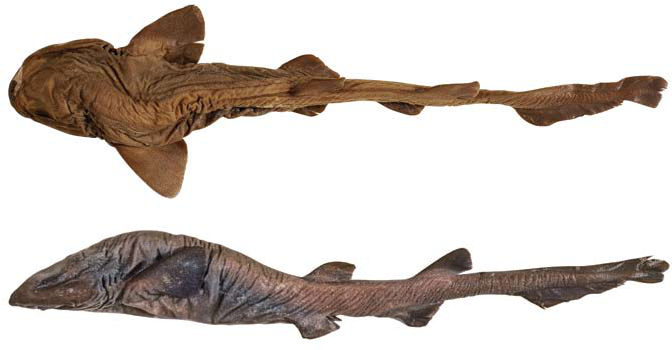Bythaelurus incanus
Last & Stevens, 2008
Dusky catshark
Classification: Elasmobranchii Carcharhiniformes Pentanchidae
Reference of the original description
Bythaelurus incanus sp. nov., a new deepwater catshark (Carcharhiniformes: Scyliorhinidae) from northwestern Australia. CSIRO Marine and Atmospheric Research Paper, 22, 123–128
Bythaelurus incanus sp. nov., a new deepwater catshark (Carcharhiniformes: Scyliorhinidae) from northwestern Australia. CSIRO Marine and Atmospheric Research Paper, 22, 123–128
Image of the original description

Ventral view of head of Bythaelurus incanus sp. nov, juvenile male holotype (CSIRO H 1204–02, 454 mm TL). In: Last, P.R. & Stevens, J.D. (2008): Bythaelurus incanus sp. nov, a new deepwater catshark (Carcharhiniformes: Scyliorhinidae) from northwestern Australia. CSIRO Marine and Atmospheric Research Paper, 22: 123-128

Ventral view of head of Bythaelurus incanus sp. nov, juvenile male holotype (CSIRO H 1204–02, 454 mm TL). In: Last, P.R. & Stevens, J.D. (2008): Bythaelurus incanus sp. nov, a new deepwater catshark (Carcharhiniformes: Scyliorhinidae) from northwestern Australia. CSIRO Marine and Atmospheric Research Paper, 22: 123-128
Description :
Citation: Bythaelurus incanus Last & Stevens, 2008: In: Database of modern sharks, rays and chimaeras, www.shark-references.com, World Wide Web electronic publication, Version 11/2025
Please send your images of "Bythaelurus incanus" to info@shark-references.com

Bythaelurus incanus sp. nov, juvenile male holotype (CSIRO H 1204–02, 454 mm TL): dorsal view; lateral view. In: Last, P.R. & Stevens, J.D. (2008): Bythaelurus incanus sp. nov, a new deepwater catshark (Carcharhiniformes: Scyliorhinidae) from northwestern Australia. CSIRO Marine and Atmospheric Research Paper, 22: 123-128

Bythaelurus incanus sp. nov, juvenile male holotype (CSIRO H 1204–02, 454 mm TL): dorsal view; lateral view. In: Last, P.R. & Stevens, J.D. (2008): Bythaelurus incanus sp. nov, a new deepwater catshark (Carcharhiniformes: Scyliorhinidae) from northwestern Australia. CSIRO Marine and Atmospheric Research Paper, 22: 123-128
Common names
 Dusky catshark
Dusky catshark
 Dusky catshark
Dusky catshark
Short Description
This species possess the following set of characters: short and broad head, its width 13.5% TL, length 19.1% TL; short snout, broadly rounded, its length 2.5 in head length; triangular anterior nasal flaps; large mouth, its width 10.3% TL, length 4.6% TL; short labial furrows confined to mouth corners; small papillae on roof of mouth; elongate abdomen, the pectoral-pelvic space 2.8 times length of pectoral-fin anterior margin, 1.7 times interdorsal space; distance of pre-dorsal about 42% TL, 10.9 times eye length; distance of anal-caudal 6.3% TL; origin of first dorsal-fin slightly behind origin of pelvic fin, while the origin of the second is well behind anal-fin mid-base; length of anal-fin base 1.2 times the second dorsal-fin base length, subequal to interdorsal space; weakly tricuspidate flank denticles, very slender crowns, their length more than twice their width; minute teeth mainly with 4 small cusps, central pair longer than those adjacent, about 100 rows in each jaw; upright flank denticles weakly tricuspidate; precaudal centra about 93, before upper caudal-fin origin; uniformly greyish brown body [3339].
This species possess the following set of characters: short and broad head, its width 13.5% TL, length 19.1% TL; short snout, broadly rounded, its length 2.5 in head length; triangular anterior nasal flaps; large mouth, its width 10.3% TL, length 4.6% TL; short labial furrows confined to mouth corners; small papillae on roof of mouth; elongate abdomen, the pectoral-pelvic space 2.8 times length of pectoral-fin anterior margin, 1.7 times interdorsal space; distance of pre-dorsal about 42% TL, 10.9 times eye length; distance of anal-caudal 6.3% TL; origin of first dorsal-fin slightly behind origin of pelvic fin, while the origin of the second is well behind anal-fin mid-base; length of anal-fin base 1.2 times the second dorsal-fin base length, subequal to interdorsal space; weakly tricuspidate flank denticles, very slender crowns, their length more than twice their width; minute teeth mainly with 4 small cusps, central pair longer than those adjacent, about 100 rows in each jaw; upright flank denticles weakly tricuspidate; precaudal centra about 93, before upper caudal-fin origin; uniformly greyish brown body [3339].
Remarks
shark-references Species-ID=656;
shark-references Species-ID=656;
















